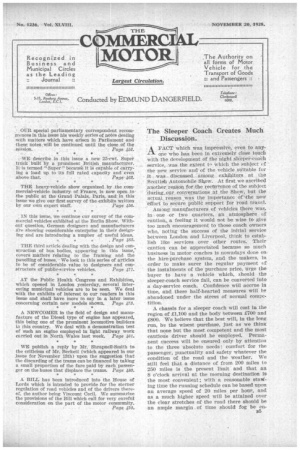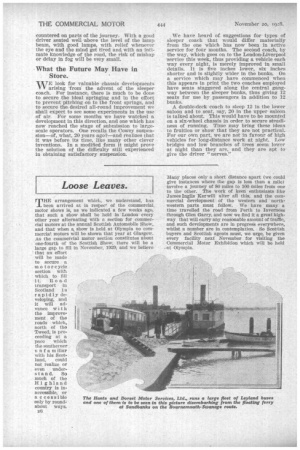-The -Sleeper Coach Creates Much : DiscOssiou.
Page 1

Page 2

If you've noticed an error in this article please click here to report it so we can fix it.
.A . FACT which.was impressive, even to any. ape who has been in extremely clOse toilet/ with the development of the night Sleepef-codeh service., was the extent to which the subject of the new service and-of the vehicle suitable for it-was discussed. .anaang: . exhibitors, at the .Scottish Automobile Show. At first we ascribed another reason forthe.recttrrence of the subject 'tluring_.our conversations at the Show, but the actual. reason -‘3,7as the importance of "the new effort to secure Pliblio suPpiart for road travel.. , Among manufacturers of vehicles there wag., in one or two quarters, on :atniOsphere of caution, a feeling it would not be wise to give too much encouragement to those coach owners who, noting the success of the initial service between London and Liverpool, think to establish like services over other routes.. Their .caution can be appreciated because so much business in motor coaches is nowadays done on the hire-purchase system, and the makers, In order to make surer the regular payment ef the instalments of the purchase price, urge the buyer to have a vehicle which, should the sleeper-coach service fail, can be converted into a day-service coach. Confidence will accrue in time, and these half-hearted measures will be abandoned under the stress of normal competition.
A chassis for a sleeper coach will cost in the region of £1,100 and the body between £700 and £800. We believe that the best will, in the long run, be the wisest purchase, just as we think that none but the most.competent and the most cautious driver should be employed. Permanent success will be ensured only by attention to the three absolute needs : comfort for the passenger, punctuality and safety whatever the condition of the road and the weather. We still feel that a distance of from 200 miles to 250 miles is the present limit and that an 8 o'clock arrival at the morning destination is the most convenient; with a reasonable stanting time the running schedule can be based upon an average speed of 20 miles per hour, and as a much higher speed will be attained over the clear stretches of the road there should be an ample margin of time should fog be en
countered on parts of the journey. With a good driver seated well-above the level of the lamp beam, with good lamps, with relief whenever the eye and the mind get tired and with an intimate knowledge of the road, the risk of mishap or delay in fog will be very small.
What the Future May Have in • Store. •
WE look for valuable chassis developments arising from the advent of the sleeper coach. For instance, there is much to be done to secure the ideal springing and in the effort to prevent pitching on to the front springs, and to secure the desired all-round improvement we shall expect to see some experiments in the use of air, For some months we have watched a development in this direction, and one which has now reached the stage of submission to largescale operators. One recalls the Cowey suspension—of, what, 20 years ago?—and realizes that it was before its time, like many other clever inventions. In a modified form it might prove the solution of the difficulty still experienced in obtaining satisfactory suspension. We have heard of suggestions for types of sleeper coach that would differ materially from the one which has now been in active service for four months. The second coach, by the way, which goes on to the London-Liverpool -service this week, thus providing a vehicle each way every night, is merely improved in small details. It is five inches lower, six inches shorter and is slightly wider in the bunks. On a service which may have commenced when this appears in print the two coaches employed have seats staggered along the central gangway between the sleeper bunks, thus giving 12 seats for use by passengers in addition to 12 bunks.
A double-deck coach to sleep 12 in the lower saloon and to seat, say, 20 in the upper saloon is talked about. This would have to be mounted on a six-wheel chassis in order to secure steadiness of running. Time may bring these ideas to fruition or show that they are not practical. For our own part, we are not in favour of high vehicles for long-distance work at night. Low bridges and low branches of trees seem lower • at night than they are, and they are apt to give the driver " nerves."








































